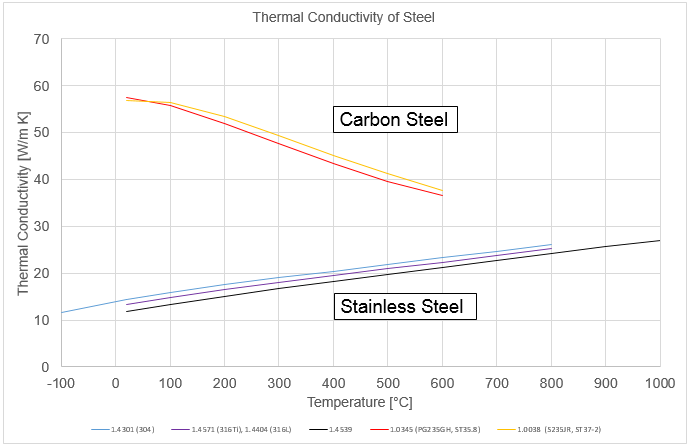Thermal conductivity pipe material
| Pipe material |
Thermal conductivity |
|
| |
W/(m K) |
ºC |
| PVC-U |
0.15 |
23 |
| PP |
0.17 |
23 |
| PVDF |
0.19 |
23 |
| PE 100 |
0.38 |
23 |
| PE 80 |
0.43 |
23 |
| Glass |
0.81 |
20 |
| Carbon Steel |
57 |
20 |
| Stainless Steel |
14 |
20 |
| Copper |
384 |
20 |
|
|

|
Thermal conductivity insulation material
The
operational thermal concuctivity
of an insulation layer is derived from its
practical thermal conductivity
and supplementary values for insulation-related thermal bridges, eg. support structures and
fixings for insulation materials (insulation of vessels).
[VDI 2055, S. 36, S. 148 ff.]. For pipes the
practical thermal concuctivity
can be used as
operational thermal conductivity.
Following reference values are taken from
[VDI 2055, S. 154 ff.].
| Insulating material |
Practical thermal conductivity in
W/(m K) |
| Mean temperature [ºC] |
-150 |
-100 |
-50 |
0 |
50 |
100 |
200 |
300 |
| Mineral wool quilted, e.g. on wire mesh apparent density >= 80 kg/m³ |
|
|
|
|
0.045 |
0.05 |
0.075 |
0.1 |
| Mineral wool mouldings (sleeves, segments) |
|
|
|
0.035 |
0.04 |
0.05 |
0.07 |
0.1 |
| Cellular glass compressive strength > 0.5 N/mm² |
0.02 |
0.025 |
0.031 |
0.04 |
0.05 |
0.06 |
0.085 |
0.11 |
| Cellular glass compressive strength > 0.7 N/mm² |
0.03 |
0.035 |
0.04 |
0.045 |
0.055 |
0.065 |
0.09 |
0.12 |
